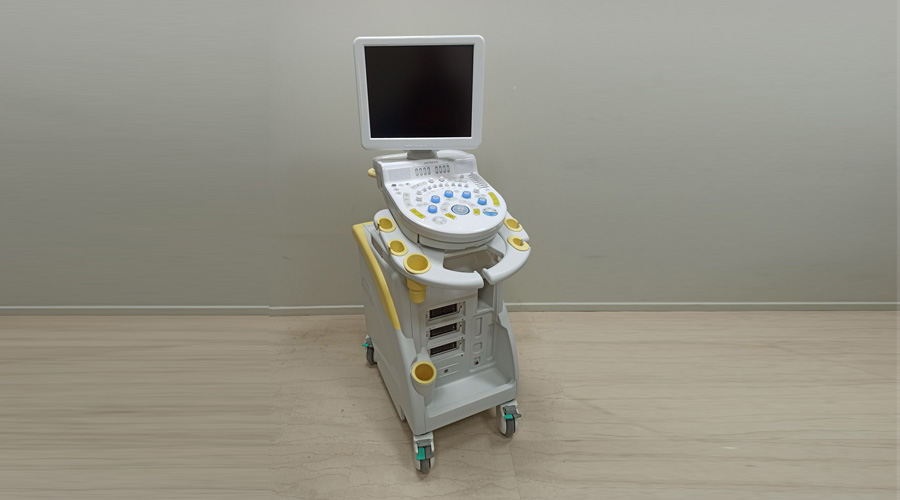
Ultrasonography
Ultrasonography is the imaging of organs and other structures within the body using high-frequency sound waves. Hearing, which is one of our five senses, is provided by "sound". Humans cannot hear every sound; However, it can hear certain sounds between 20-20000 Hertz. Sounds far above 20000 Hertz, which is the sound limit that humans cannot hear, are used in medicine. This method is called "Ultra Sono Graphics" (USG). Since the frequencies we know are used, even though the frequencies are very high, The examination does not cause any harm to the body. No harmful radiation such as X-rays is used. An ultrasound instrument has two main parts: the main unit and the probe. The piece of ultrasound placed on the body area being examined during the examination is called a "probe". High frequency sounds are converted into electrical energy through the transducer in the probe. The energy created by the sound waves coming from the body is also converted into electrical energy via the transducer. These changes take place in the piazoelectric crystals inside the probe. Thus, the sound waves coming from the body are converted into images and made visible on the TV screen. The image created is called a "sonogram". These images can be saved instantly with the printer (photo printing tool).
Ultrasonography is most useful in examining fluid-containing organs and structures. Solid structures such as bones and air-filled organs such as lungs (since they do not contain much fluid) do not look well on ultrasound. However, masses and solid formations in fluid-containing organs can be observed. Ultrasonography is used in various fields: examining the abdominal organs (abdominal USG), gynecological diseases (gynecological USG), pregnancy and birth follow-up (obstetric USG), examination of heart functions and structure (echocardiography), examination of breast tissue (mammography), vessels -In the examination of organs and structures such as thyroid-testis-eye etc... Different ultrasound devices and probes are used according to the location and characteristics of the organ being examined. In ultrasonography, the probe is generally moved over the body (as in abdominal USG). There are also types of USG: Transvaginal, transrectal..
PREPARATIONS TO BE MADE BEFORE THE EXAMINATION:
Except for emergencies, the patient's fasting 12 hours before, medication the night before, etc. The bowels should be emptied using (for upper abdomen USG), a fat-free diet should be applied one day before the test, (for kidney, bladder and gynecological USG) 1.5-2.5 liters of liquid (water) should be drunk before the examination and the bladder should be completely filled. The examination is usually done in the morning. If these conditions are met, it can be done at any time of the day.
APPLICATION (PERFORMANCE OF THE EXAMINATION) :
The ultrasound image of the abdomen or any part of the body is obtained by taking various sections of that region. The patient lies first on his back, then (if necessary) on his face and side; The ultrasound probe is brought into contact with the body at different angles. Gel is applied to the body surface in order to prevent the loss of ultrasound waves between the body and the probe. The gel creates a bridge between the probe and the body.
ORGANS INSPECTED:
Ultrasound examination of intra-abdominal organs is called "abdominal ultrasonography". In medicine, the word abdomen is generally used instead of abdomen. Latin for abdomen..
Abdominal Ultrasonography is divided into two according to the abdominal region:
- Upper Abdominal Ultrasonography,
- Lower Abdominal Ultrasonography.
If both are done together, it is called "Whole Abdominal Ultrasonography".
The following organs and structures are examined in upper abdominal ultrasonography:
Liver, gallbladder and biliary tract, kidneys and adrenal glands, major vessels such as spleen, pancreas, abdominal aorta and VCI, lower end of esophagus.
In the lower abdomen ultrasonography :
Bladder in men and women; prostate in man; In women, uterus (womb), ovaries (ovaries), tubas, Douglas cavity are examined. Abnormalities such as lymphadenopathy, mass (tumor, etc.), cyst, and fluid collection can also be detected in the whole abdominal ultrasonography.
CONDITIONS REQUIRED ULTRASOUND:
Situations where ''Whole Abdominal Ultrasonography'' examination is required are as follows:
* Abdominal pain (started a few hours ago or may be continuous)
*Painful and/or bloody urination (may be accompanied by nausea and vomiting), intermittent urination
* Yellowing of the eyes and body, pain in the upper-right side of the abdomen
* Having kidney disease, kidney stone, diabetes, etc. in the family
*Persistent digestive complaints such as indigestion and nausea
*Continuous swelling of the abdomen
*Abdominal trauma such as a traffic accident or a hard blow to the abdomen (if there is a risk of internal organ rupture or bleeding)
* In patients with suspected abdominal tumor (mass), cyst or aortic enlargement
*If congenital abnormality or absence of intra-abdominal organs is thought
*For the determination of the size and structure of organs
*As part of general health screening (for check-up purposes)
DISEASES WITH MOST COMMON ULTRASOUND
Kidney stones, urinary tract infections, stones and infections in the gallbladder and bile ducts, spleen and liver enlargement, prostate enlargement (in men over 50), and gynecological diseases are mostly investigated with ultrasound. Ultrasound is also frequently used in pregnancy follow-up.
ELEMENTS AFFECTING THE EXAMINATION:
- Contrast substances such as gas in the intestines, stool or barium that has remained in the intestine from an examination done in the last two days
- Movement of the patient during the examination (especially children)
- Excess adipose tissue in obese people
- Open wound in the body area to be ultrasound
ADVANCED EXAMINATIONS:
Further tests that may be required after ultrasonography include: :
- blood tests
- biopsy
- IVP, ERCP, PTK etc.
- Computed Tomography
- Magnetic resonance